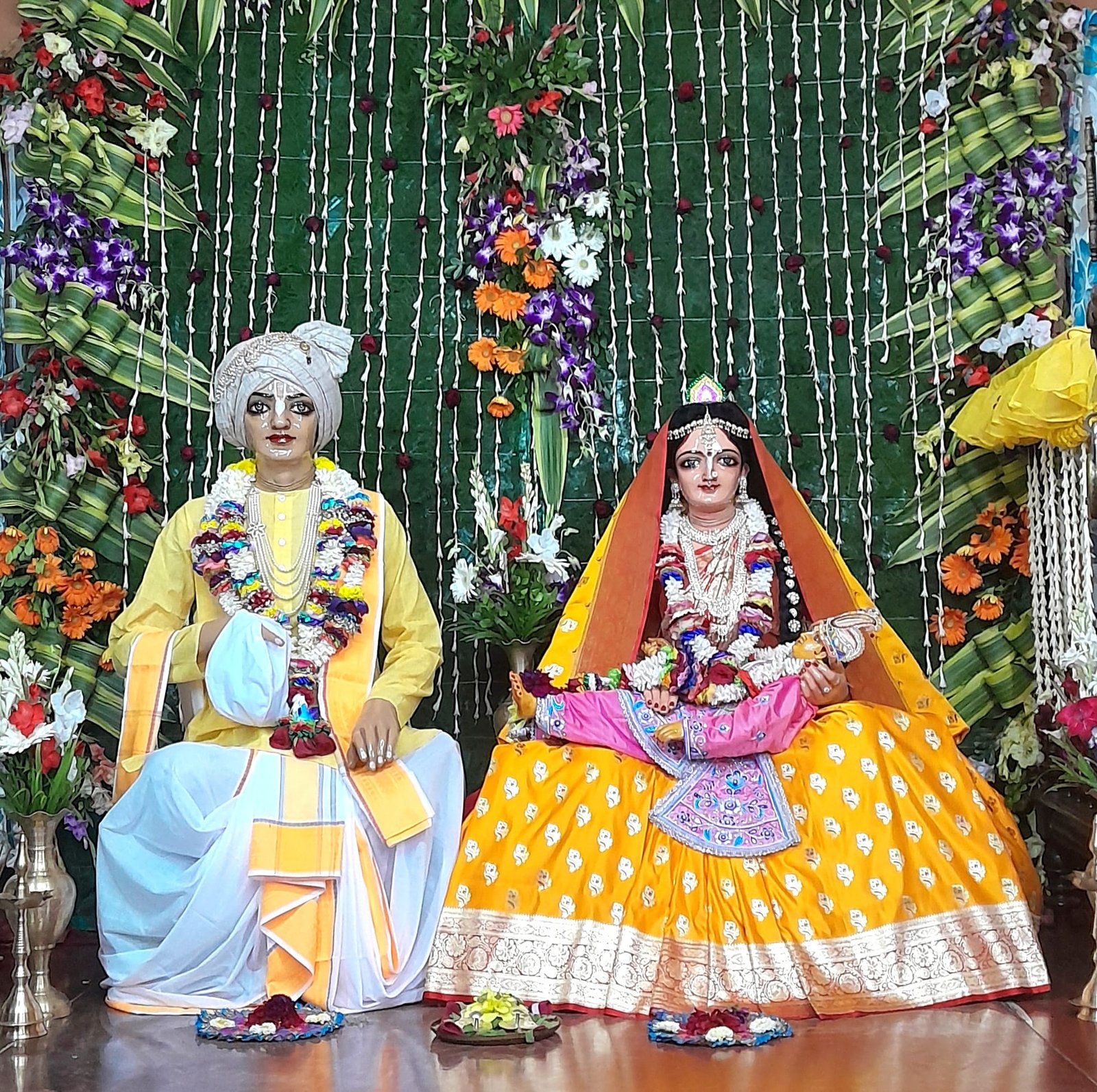
Sri Sacidevi & Jagannatha Misra & Nimai
Information – Next to the Neem tree is a small hut which has the deities of Jagannatha Misra and Sachimata (Sri Chaitanya’s parents) holding young Nimai on her lap. This is the area where Sri Chaitanya had all of his childhood and boyhood pastimes until the time he took to the renounced order of life.
First Lord Kṛṣṇa made His parents and elders appear. Then Kṛṣṇa Himself, with the sentiments and complexion of Rādhikā, appeared in Navadvīpa, like the full moon, from the womb of mother Śacī, which is like an ocean of pure milk.
(CC Adi 4.271-272)
(5) From the Kṛṣṇa-yāmala-tantra: puṇya-kṣetre nava-dvīpe bhaviṣyāmi śacī-sutaḥ. “I shall appear in the holy land of Navadvīpa as the son of Śacī-devī.”
(6) From the Vāyu Purāṇa: kalau saṅkīrtanārambhe bhaviṣyāmi śacī-sutaḥ. “In the Age of Kali when the saṅkīrtana movement is inaugurated, I shall descend as the son of Śacī-devī.”
“Sometimes I personally appear on the surface of the world in the garb of a devotee. Specifically, I appear as the son of Śacī in Kali-yuga to start the saṅkīrtana movement.”
(CC Adi 2.22)
All the good qualities of Kaśyapa, Daśaratha, Vasudeva, and Nanda Mahārāja were found in the person of Jagannātha Miśra.
COMMENTARY
All personifications of pure goodness like Kaśyapa Muni, the father of Upendra; Daśaratha, the father of Rāmacandra; Vasudeva, the father of Vāsudeva; and Nanda Mahārāja, the father of Vrajendra-nandana, were all simultaneously manifested in the person of Jagannātha Miśra.
(Śrī Caitanya-bhāgavata, Ādi-khaṇḍa 2.138)
Jagannātha Miśra was overwhelmed with ecstasy upon hearing the child’s glories, and he desired to give something in charity to the brāhmaṇa. But because Jagannātha Miśra was extremely poor, he simply took hold of the brāhmaṇa’s feet and cried. The brāhmaṇa then grabbed hold of Jagannātha Miśra’s feet and cried, while the people present there chanted, “Hari! Hari!” in ecstasy. Hearing the Lord’s extraordinary horoscope, the friends and relatives there happily chanted, “Jaya! Jaya!”
(Śrī Caitanya-bhāgavata, Ādi-khaṇḍa 3.29 – 3.32)
Jagannātha Miśra was always enthusiastic in following his religious principles while residing in Navadvīpa. He was equal to Vasudeva, the father of Lord Kṛṣṇa.
(Śrī Caitanya-bhāgavata, Ādi-khaṇḍa 1.93)
I offer my respectful obeisances at the feet of Jagannātha Miśra’s son, whose attractive form defeats the beauty of millions of moons.
(Śrī Caitanya-bhāgavata, Madhya-khaṇḍa 2.275)
In this way Śacī, the mother of the universe, constantly tolerated all of Gaurāṅga’s mischievous activities.
(Śrī Caitanya-bhāgavata, Ādi-khaṇḍa 8.162)
In Navadvīpa, everyone had forgotten where the birthplace of Mahāprabhu was located. Five hundred years ago, Navadvīpa was a very large area which used to comprise of nine islands. Thousands of brāhmaṇas and paṇḍitas used to reside there. This used be be the major center for studies and learning . . . Navadvīpa. Even now, there are big, big paṇḍitas in Navadvīpa. Navadvīpa is in West Bengal, and Vārāṇasī is in Uttar Pradesh. Then, Darbhaṅga. There were many places there, just as now there is Calcutta University etc, that in the earlier times were the places of education and learning. As all of you know, here in Navadvīpa, Caitanya Mahāprabhu appeared. His father came from Sylhet where he used to reside on the banks of Gaṅgā. His wife was Śacī-devī, the daughter of Nilambar Cakravartī Ṭhākura. Bhaktivinoda Ṭhākura was very keen to find the original birthplace of Mahāprabhu. People used to say that Mahāprabhu’s birthplace had disappeared, but he did not believe that.
There was a tulasi forest at Yoga-pīṭha in to Māyāpura where Jagannātha dāsa Bābājī would sing bhajana. He revealed to Bhaktivinoda Ṭhākura that this was the place where Mahāprabhu appeared. “mahājano yena gataḥ sa panthāḥ”
Jagannātha dāsa Bābājī was very old. He would constantly chant Hari-nāma. He lived in Vṛndāvana, and later moved (to Māyāpura) and lived here. Based on his revelation, Bhaktivinoda Ṭhākura tried his utmost to develop the place to the best of his financial ability. He took charge of the place, and then he formed the ‘Dhāma Pracārinī Sabhā’ to invoke the interest of the people.
(740929 – Lecture Bengali – Mayapur)
Information – One time at Bhakti Vijaya Bhavana around midnight a sound woke Sevā-vilāsa Brahmacārī. He arose and beheld Śrīla Sarasvatī Ṭhākura striding toward the south, absorbed in thought. Seeing him going alone in the deep night, Sevā-vilāsa Prabhu thought it wise to follow. Reaching the Yogapīṭha Śrīla Sarasvatī Ṭhākura prostrated in respect, and after proceeding a little farther south he repeatedly cried “Hā Śacīnandana Gaurahari!” and again made daṇḍavat. Soon tumultuous kīrtana became audible, and many devotees approached, sounding mṛdaṅgas, karatālas, conchs, and gongs. Śrīla Sarasvatī Ṭhākura offered daṇḍavat to them. They reciprocally offered daṇḍavat and then said, “Śrīla Sarasvatī Ṭhākura, today we are graced with darśana of the lotus feet of you who are an eternal associate of Lord Caitanya and a most dear mañjarī of Rādhā. Glance mercifully upon and favor the lowly fallen souls. By your mercy, that of Śrī Gaurasundara and His dhāma is attained.” In humility-laden tones Śrīla Sarasvatī Ṭhākura replied, “You are all Vaiṣṇavas of Śvetadvīpa, eternal Gaura-dhāma-vāsīs and servants of Lord Caitanya. Our only desire is to attain your mercy.”
Those divine beings offered prayers to Śrīla Sarasvatī Ṭhākura and then resumed kīrtana. They offered daṇḍavat before the Yogapīṭha, plaintively crying, “Hā Śacīnandana! Hā Gaurahari! Please reveal Your dhāma and form. Hā Śacīdevī! Hā Jagannātha Miśra! Mercifully bestow upon us service to Śrī Gaurahari.” After circumambulating the Yogapīṭha temple four times while performing kīrtana, they rolled in the dust of the adjacent forecourt of Śacīdevī. Then, seating Śrīla Sarasvatī Ṭhākura before them, with folded hands they most respectfully said, “Śrīla Sarasvatī Ṭhākura! You are Śrī Gaurahari’s dearest servant, the fulfiller of his manobhīṣṭa. Having heard of your qualities from Lord Caitanya’s topmost associates, we came for darśana of your lotus feet and to hear from you the pastimes enacted by Lord Gaura on this earthly plane. Kindly fulfill our entreaty.” After begging their blessing to recite, Śrīla Sarasvatī Ṭhākura discoursed on Gaura-līlā-kathā as described in authoritative biographies, enriched with his own unique realizations and siddhāntic explanations of its intricacies, nonstop until the chirping of the birds of the dhāma announced the coming aurora. Before parting, the residents of Śvetadvīpa requested Śrīla Sarasvatī Ṭhākura to speak Gaura-līlā-kathā to them every night. Then he and they offered mutual daṇḍavat and returned to their respective abodes.
(“Sri Bhaktisiddhanta Vaibhava” Volume Two by HH Bhakti Vikasa Swami, Chapter ‘Dhama-Seva’, Page 386)
